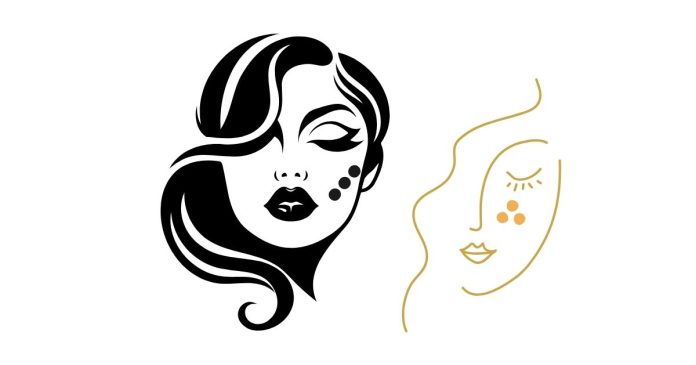The tattoo of three dots on the face, particularly near the eyes, is a symbol with several different meanings and cultural connotations, depending on the context and the region where it’s used. The three dots, typically arranged in a triangular formation (often above or around the eyes), have been popularized in modern tattoo culture, especially among certain subcultures. Below is a detailed exploration of what the “three dots” tattoo on the face can mean:
1. Prison Culture
One of the most widely recognized meanings of the three dots tattoo, especially when it appears on the face, is its association with prison culture. This tattoo is commonly seen among incarcerated individuals, particularly in the United States and Latin America.
- Meaning of the Three Dots: In prison culture, the three dots are often used to symbolize “mi vida loca,” which translates to “my crazy life” in English. This phrase refers to a life filled with struggle, crime, or chaos. It’s a representation of someone who lives a turbulent or dangerous life, typically someone who has been involved in gangs, criminal activity, or has experienced a difficult, lawless lifestyle.
- Positioning: When tattooed near the eye (typically on the face), it can be a badge of honor for individuals who have served time and are affiliated with certain prison gangs. The dots are often placed in the shape of a triangle, signifying a strong affiliation with this lifestyle and marking the wearer as someone with significant experience in the criminal world.
2. Latin American Gang Symbolism
In Latin American gang culture, the three dots tattoo can carry a similar meaning to that of the general prison culture. It is commonly seen among members of street gangs and is used to symbolize affiliation with gangs that operate within a rough and often dangerous environment.
- Symbol of Survival: The tattoo can signify the survival of hardship or the resilience of someone who has endured the difficulties of gang life, often in the streets or in prison.
- Visual Representation: The placement of the dots and the particular configuration can vary. Sometimes, the three dots are inked above the eye, while other times, they can be placed on the temple or other areas of the face. In some cases, they could be arranged in a pattern or style that signifies a specific gang or subgroup.
3. Representing a Tragic or Hard Life
In some cases, the three dots tattoo can represent a tragic or difficult life. This can include themes such as loss, hardship, and a troubled past, regardless of whether the person has been involved in criminal activity.
- Mental Health Struggles: For some individuals, the three dots tattoo can also symbolize a history of personal battles with mental health issues, addiction, or trauma. It may indicate that the wearer has faced significant life challenges that have shaped their identity.
- Philosophical Meaning: In certain circles, particularly in countercultures, the three dots might symbolize the idea of “everything being connected” or represent a philosophy of accepting life as it comes, no matter how chaotic or difficult. The dots may stand for the past, present, and future, or for different stages of a person’s life.
4. Indigenous and Cultural Meanings
In some indigenous cultures, the three dots tattoo might hold meanings that are deeply rooted in the spiritual or symbolic realms, though this is less common in mainstream tattoo culture today.
- Symbolic Representation: The three dots may have spiritual connotations, representing significant numbers or patterns in the wearer’s cultural or religious practices. For example, in some native or tribal cultures, the number three holds symbolic meaning and may be associated with balance, harmony, or the interconnection of life, death, and rebirth.
- Sacred Geometry: In certain belief systems, dots arranged in patterns can represent unity and the cyclical nature of life or creation. These interpretations are much rarer and vary widely between different cultures.
5. Hip-Hop and Street Fashion Influence
The three dots tattoo, especially on the face, has also been influenced by hip-hop and street fashion cultures. In these settings, it can sometimes be a form of self-expression or a fashion statement, detached from the more negative associations with prison life and gangs.
- Popularity in the Music Industry: Some artists or individuals who have been influenced by hip-hop culture might adopt the three dots tattoo as a form of artistic self-expression or rebellion against societal norms.
- Sign of Rebellion: In some circles, especially in more mainstream, non-gang contexts, the three dots on the face could be an act of defiance or a form of personal branding. It’s seen as a form of rebellion or challenging traditional beauty standards, as face tattoos are typically considered bold or extreme.
6. Other Possible Meanings
There are a few other interpretations of the three dots tattoo that aren’t as widely known but could be used by certain individuals for personal reasons:
- Minimalist Design: Some people may choose the three dots tattoo for purely aesthetic reasons, appreciating the minimalist nature of the design. For these individuals, the tattoo may not carry any deep meaning beyond the visual appeal or the personal significance of having a simple, striking symbol on their face.
- Personal or Private Meaning: As with many tattoos, the three dots could have a deeply personal or private meaning known only to the wearer. This could include anything from marking a transformative moment in their life to representing something meaningful in their family or relationships.
Conclusion
The three dots tattoo on the face is a symbol with a variety of meanings, depending on the cultural, social, and personal context in which it is used. In prison culture, it often represents a life of hardship and struggle, sometimes tied to gang affiliation or criminal activity. In other contexts, it could symbolize resilience, a difficult past, or personal survival. While it is heavily associated with certain subcultures, it can also be used in more personal or aesthetic ways, especially in modern tattoo trends.


